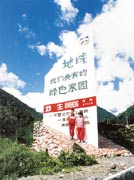|
 The Wolong Natural Reserve has very beautiful and peculiar natural landscape; every year, over 100,000 visitors from all over the world come to do scientific research, investigation, teaching, field work, and tourism. For this reason, the reserve takes this opportunity to organize various activities to teach the public how to conserve local environment. The Wolong Natural Reserve has very beautiful and peculiar natural landscape; every year, over 100,000 visitors from all over the world come to do scientific research, investigation, teaching, field work, and tourism. For this reason, the reserve takes this opportunity to organize various activities to teach the public how to conserve local environment.
A series of measures has been taken, making environmental protection signs and sculptures, and distributing and selling materials and audiovisual products at key scenic spots. These are all aimed to introduce knowledge of Nature and environmental protection to enhance the awareness of visitors. According to statistics, the natural reserve has printed and distributed more than ten types of materials, numbering over 100,000 copies, and nearly 10,000 copies of CD. And advocating stations were sep up to carry out distribute these materials for free all through the year. Dozens of environmental protection signs with both pictures and signs have been made. During national holidays, like 51, the National Day, and the New Year holiday, environmental protection propaganda has been particularly stressed. In addition, the policy of free visit for students has been consistently carried out. All these measures have helped in teaching the public how to conserve natural environment.
Another important means taken is making full use of the resource of scientific researchers. Through the explanation and introduction of the researchers, visitors can systematically know wildlife resources in the reserve, especially information about the giant panda. And through knowing these precious wild animals and plants, visitors will have a better awareness of environmental protection.
Accompanied by experienced working staff of the reserve, visiting students and researchers can go to the wild and do field work. These people, when going back, will further advocate what they have learnt here.
Journalists and other people who come here for interviewing and making movies or TV are also warmly received. And correspondents of the reserve are also encouraged to contribute reports to newspapers of all levels - pop science publications in particular - to amply the influence of the reserve and introduce the reserve to the public. Apart from this, to arouse people's concern and love for the giant panda and our environment, various popular science activities have been organized, for instance, World Science Fiction Annual Conference and Chengdu International Giant Panda Festival.
Inside the Wolong Natural Reserve, China Conservation and Research Center for Giant Panda and China Giant Panda Museum are both working hard to organize various public education programs while carrying out their own research projects. They have set a good example for others to follow.
China Conservation and Research Center for Giant Panda and China Giant Panda Museum sponsored the "Giant Panda's Club." With their advocating, nearly 600 individuals and institutions joined the club and became members of it. At the same time, the management of the club is also stressed, and frequent and regular contact with the members has been established. The members are timely informed about new achievements and progress of giant panda research and adoption to reinforce their sense of responsibility and awareness of nature. On the other hand, through distributing scientific materials and organizing investigations and visits, scientific knowledge about the giant panda and other wild animals, and ecology and environment has been greatly popularized.
The teaching the public how to conserve nature program also takes form of lectures, tourist guide's introductions, video tapes, propaganda logos, wall papers and pamphlets. It is aimed to popularize knowledge about the giant panda and nature to all visitors, including visiting teachers and students for research.
The Home of Giant Panda---Chushuigou
Teaching the Local People How to Conserve the Environment
|



